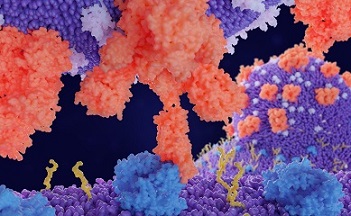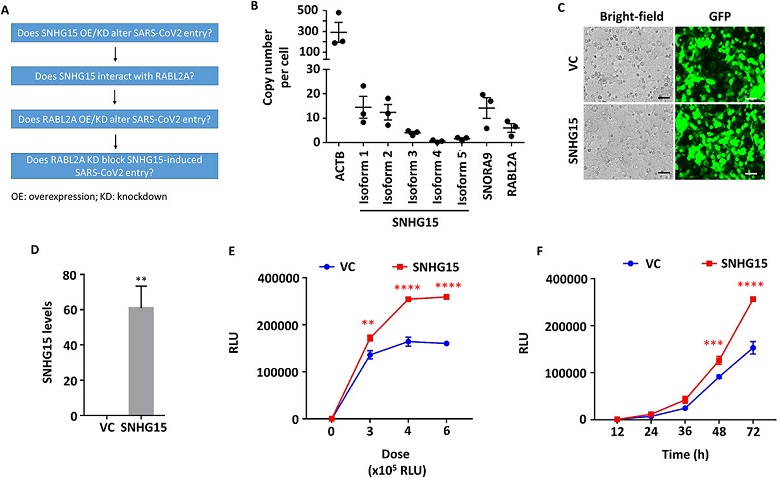BREAKING NEWS! U.S. Study Reveals A Fascinating Role Of Long Noncoding RNA SNHG15 In Aiding SARS-CoV-2 Cell Entry Via Oncogene RABL2A!
Thailand Medical News Aug 04, 2023 2 years, 4 months, 1 week, 6 days, 18 hours, 19 minutes ago
Thailand Medical: The ongoing COVID-19 pandemic, caused by the severe acute respiratory syndrome coronavirus 2 (SARS-CoV-2), has been a global health crisis since its emergence in 2019. To date, it has resulted in millions of confirmed cases and deaths worldwide. Scientists and researchers around the world have been tirelessly studying the virus to better understand its biology and identify potential targets for therapeutic interventions.

One of the key areas of investigation has been the entry mechanism of the virus into host cells. Angiotensin-converting enzyme 2 (ACE2) has been identified as the primary receptor through which SARS-CoV-2 binds and enters cells although there are also many other human host receptors that it can also use for cell entry. Additionally, several proteins have been recognized as co-factors that enhance the binding of the virus to ACE2 receptors. However, a novel and intriguing finding has emerged from a study conducted at Oklahoma State University, USA.
This groundbreaking study explored the involvement of long noncoding RNAs (lncRNAs) in the process of SARS-CoV-2 entry. LncRNAs are a class of RNA molecules that do not encode proteins but have been found to play critical roles in the regulation of various diseases, including viral infections.
The study team focused their attention on a specific lncRNA called Small Nucleolar RNA Host Gene 15 (SNHG15). Previous studies had suggested that SNHG15 might be involved in the pathogenesis of viral infections, and the study team were keen to investigate its potential role in SARS-CoV-2 entry.
To assess the impact of SNHG15 on SARS-CoV-2 entry, the researchers utilized a SARS-CoV-2 spike pseudotyped lentivirus, which carries a luciferase reporter. This lentivirus allowed them to study the effects of manipulating SNHG15 levels in host cells.
The results of the study were astonishing. Overexpression of SNHG15 in cells significantly promoted SARS-CoV-2 entry, while knockdown of SNHG15 led to a reduction in viral entry. These findings were further validated in a dose- and time-dependent manner, demonstrating the critical role of SNHG15 in facilitating SARS-CoV-2 entry.
But how does SNHG15 exert its influence on SARS-CoV-2 entry? The study team delved deeper into the molecular mechanisms underlying this phenomenon. They discovered that SNHG15 interacts with a protein called Rab-like protein 2A (RABL2A) which also happens to be an oncogene!
To confirm the significance of RABL2A in the process, the study team performed additional experiments where they overexpressed and knocked down RABL2A. Intriguingly, the effects of manipulating RABL2A levels mirrored those observed with SNHG15. This suggested that RABL2A is also a crucial player in SARS-CoV-2 entry.
In an exciting twist, the study team found that knocking down RABL2A abolished the increase in SARS-CoV-2 entry mediated by SNHG15. This finding strongly indicated that SNHG15 aids SARS-CoV-2 entry through its interaction with RABL2A. The relationship between SNHG15 and RABL2A in promoting viral entry opened up new avenues for future research into potential therapeutic strategies.
Corresponding author, Dr Lin Liu, from the Oklahoma Center for Respiratory and Infectious Diseases- Oklahoma State University told
Thailand Medical
ong> News, “Our study is the first report of a functional role of SNHG15, a conserved lncRNA, in SARS-CoV-2 entry. Using pseudotyped lentiviral particles with SARS-CoV-2 spike protein, we determined the functional role of SNHG15 in SARS-CoV-2 entry. Overexpression and knockdown studies revealed that SNHG15 promotes SARS-CoV-2 entry into cells. RABL2A, an interacting partner of SNHG15, showed similar activity in SARS-CoV-2 entry. Knockdown of RABL2A significantly blocked the SNHG15-mediated entry of SARS-CoV-2, indicating that SNHG15 aids SARS-CoV-2 entry through RABL2A.”
SARS-CoV-2, like other coronaviruses, relies on receptor-mediated endocytosis to enter host cells. Following entry, the virus releases its genomic RNA into the cell cytoplasm, leading to viral replication and the production of new virions. Although the role of structural proteins in SARS-CoV-2 assembly and budding is not fully understood, they are known to assist in these processes.
 SNHG15 overexpression enhances SARS-CoV-2 entry into cells. (A) an experimental design schematic diagram. (B) Copy numbers of SNHG15, SNORA9 and RABL2A in HEK293T-ACE2 cells as determined by droplet digital PCR. (C-F) HEK293T – ACE2 cells were transfected with 100 ng of vector control (VC) or SNHG15 isoform 1overexpression plasmids (C, D) for 24 h, followed by infection with SARS-CoV-2 pseudovirus at the indicated doses for 72 h (E) on the X-axis or at a dose of 6 × 105 relative luciferase units (RLUs) for the indicated time points (F). The transfection efficiency of VC and SNHG15 overexpression plasmids is indicated by GFP (C). Scale bar: 100 µm. SNHG15 levels were determined by real-time PCR and were normalized to β-actin (D). Luciferase activity levels representing SARS-CoV-2 entry (Y-axis) were measured in the infected cells, and the results are expressed as RLUs (E, F). Data are expressed as the means ± SEs. *p < 0.05, **p < 0.01, ***p < 0.001, ****p < 0.0001 vs. the VC of the respective doses or time points (n = 3)
SNHG15 overexpression enhances SARS-CoV-2 entry into cells. (A) an experimental design schematic diagram. (B) Copy numbers of SNHG15, SNORA9 and RABL2A in HEK293T-ACE2 cells as determined by droplet digital PCR. (C-F) HEK293T – ACE2 cells were transfected with 100 ng of vector control (VC) or SNHG15 isoform 1overexpression plasmids (C, D) for 24 h, followed by infection with SARS-CoV-2 pseudovirus at the indicated doses for 72 h (E) on the X-axis or at a dose of 6 × 105 relative luciferase units (RLUs) for the indicated time points (F). The transfection efficiency of VC and SNHG15 overexpression plasmids is indicated by GFP (C). Scale bar: 100 µm. SNHG15 levels were determined by real-time PCR and were normalized to β-actin (D). Luciferase activity levels representing SARS-CoV-2 entry (Y-axis) were measured in the infected cells, and the results are expressed as RLUs (E, F). Data are expressed as the means ± SEs. *p < 0.05, **p < 0.01, ***p < 0.001, ****p < 0.0001 vs. the VC of the respective doses or time points (n = 3)
Understanding the molecular mechanisms underlying viral entry and replication is essential for the development of targeted antiviral therapies. This study's findings not only shed light on the involvement of lncRNAs in SARS-CoV-2 infection but also highlight the significance of identifying critical host factors in virus replication.
The discovery of SNHG15's role in SARS-CoV-2 entry may pave the way for the development of novel therapeutic interventions. Targeting SNHG15 or its interaction with RABL2A could potentially disrupt the virus's entry process, limiting its ability to infect host cells. However, further research is needed to fully elucidate the molecular details of this interaction and its potential as a therapeutic target.
This study also exemplifies the power of cutting-edge molecular biology techniques in unraveling the complexities of viral infections. Scientists worldwide are collaborating to deepen our understanding of SARS-CoV-2 and develop effective strategies to combat its spread.
A worrying point of the study however is that SARS-CoV-2 could lead to the upregulation of the cancer gene RABL2A!
In conclusion, the U.S. study conducted at Oklahoma State University has uncovered a fascinating connection between long noncoding RNA SNHG15 and the oncogene RABL2A in aiding SARS-CoV-2 entry into host cells.
This groundbreaking discovery marks a pivotal moment in our understanding of the virus's biology and opens up exciting possibilities for the development of targeted antiviral therapies.
The study findings were published in the peer reviewed journal: RNA Biology (Taylor & Francis).
https://www.tandfonline.com/doi/full/10.1080/15476286.2023.2241755
For the latest SARS-CoV-2 Research, keep on logging to
Thailand Medical News.

